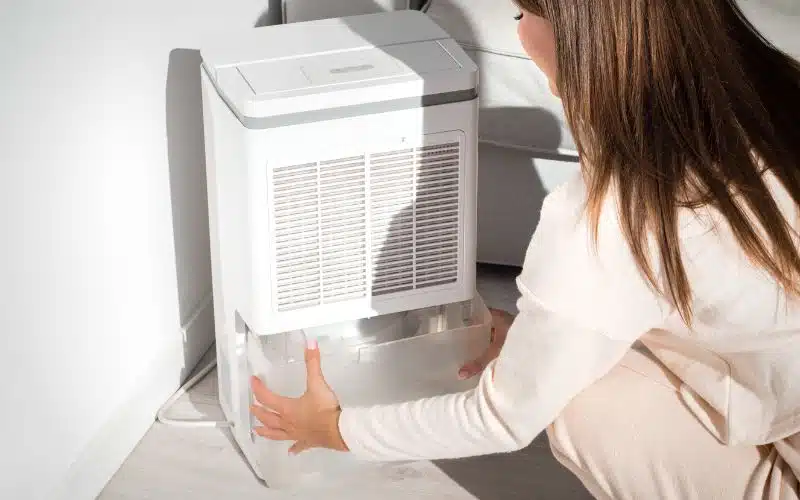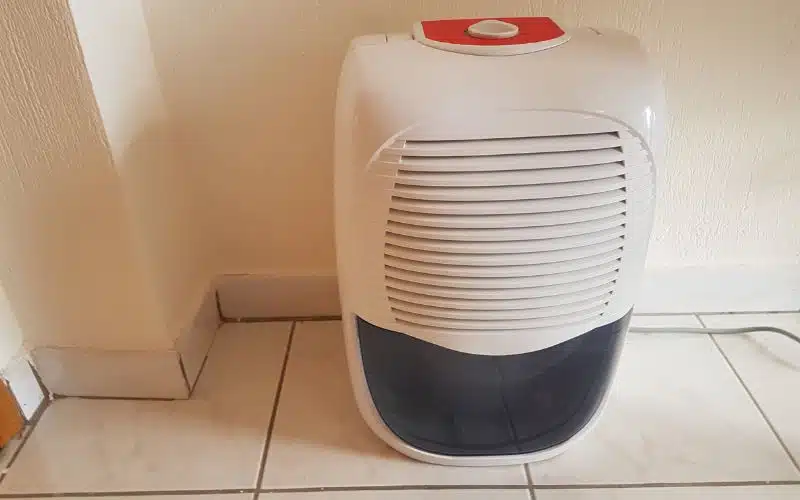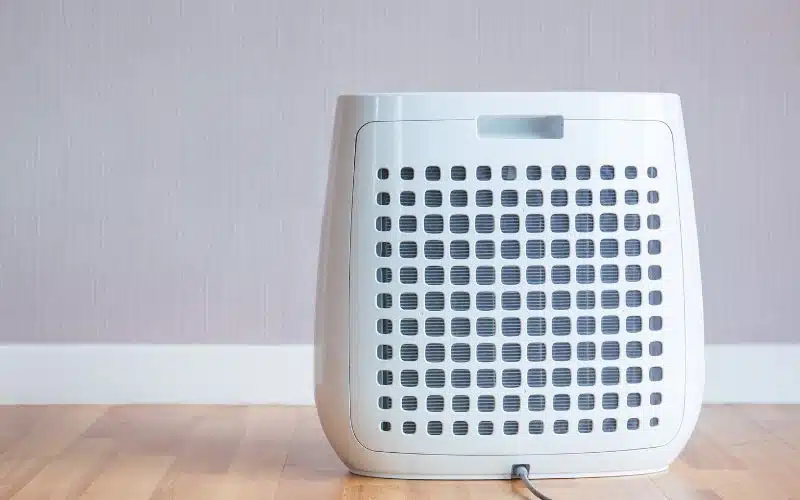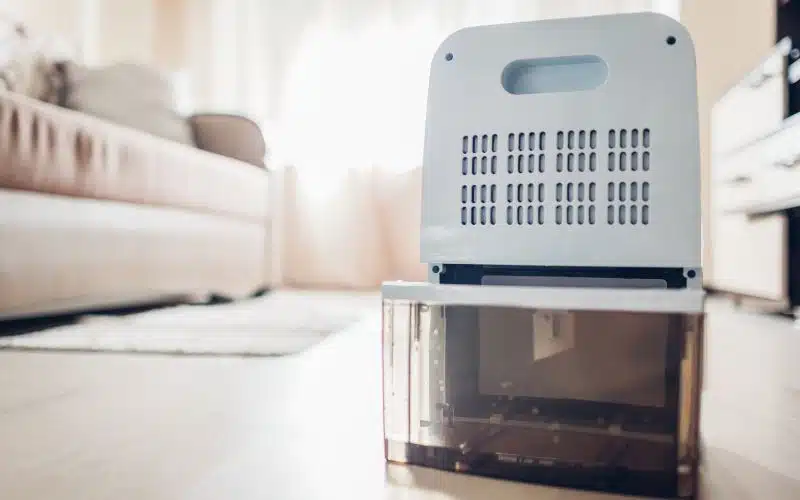A hisense dehumidifier is an appliance that reduces the amount of relative humidity (RH) in rooms.
It uses a compressor and a fan to pull in the air in the room and reduce its temperature, forcing water vapor to condense.
Hisense dehumidifiers have three modes: auto-dry, continuous, and manual. But we will be focusing on auto dry mode.
So, what does auto dry mode mean on Hisense dehumidifiers?
The Auto Dry Mode in Hisense dehumidifiers allows users to control humidity in their surroundings accurately. This feature adapts its functions according to the present humidity in a room and reduces the humidity to acceptable levels. It also plays an important role in increasing the air quality of your home or workplace.
In this article, I will explain all the functions of auto dry mode, how to set your Hisense dehumidifier to auto dry mode and draw comparisons between it and other modes.
What is the Auto Dry Mode on Hisense Dehumidifiers?

The auto dry mode on Hisense dehumidifiers sets the relative humidity to 50 percent and the fan speed to auto.
Auto dry is one of three modes found on Hisense dehumidifiers: auto dry mode, continuous mode, and manual setting.
These modes are very similar because they all reduce humidity, but they do so at different rates.
The auto-dry mode is one of the most used modes on Hisense dehumidifiers because it sets the relative humidity to an acceptable 50 percent with just a click of a button.
You can use the auto-dry mode to prime a room with an acceptable RH factor in different weather conditions.
The auto-dry mode is perfect for rainy days when the atmosphere is cold and damp.
Users also get better efficiency with the auto dry mode as the compressor starts and stops periodically to keep a room’s relative humidity constant.
Let’s briefly examine the other modes of Hisense dehumidifiers.
#1. Continuous Mode
The continuous mode is the next mode available on Hisense dehumidifiers, and unlike the auto dry mode, this mode runs the unit continuously without pause.
Running the dehumidifier in continuous mode might incur higher electricity bills, but it is a good way to reduce the humidity in a room quickly.
In this mode, you won’t be able to change the relative humidity setting because it is at the lowest the dehumidifier supports.
#2. Manual Mode
You can manually tweak all the dehumidifier settings, starting from the fan speed, timer, and relative humidity settings.
The manual mode has the highest customizable settings; you can set the relative humidity to fit different weather conditions.
Users can also set a timer that will turn the unit off when the timer reaches zero.
Adjustable fan speed is also a plus because you can reduce the RH of a room faster or slower depending on your set fan speed.
If you wish to change the settings of the dehumidifier, you need to know what each button does.
Here is a table identifying the various buttons on the dehumidifier and their uses.
| Button | Function |
|---|---|
| Power button | Turns the dehumidifier on and off |
| Mode button | Pressing the mode button cycles the dehumidifier between auto-dry, continuous, and manual modes. |
| Fan speed button | This button changes the fan speed from high to low and auto |
| Timer button | The timer button delay start or delays stop the dehumidifier |
| Clean filter button | This indicator/button turns on when the air filter is dirty, and pressing it resets the filter after cleaning. |
What is the RH set on in the Auto Dry Mode?
The filter’s relative humidity is 50 percent when the auto-dry mode is engaged.
You should do well to remember that the dehumidifier reduces the humidity based on the relative humidity of the air in the room.
If you have any open windows or doors in the room, the dehumidifier’s performance will be affected, wasting energy.
Ambient humidity varies a lot from season to season because of the temperature of the air and weather conditions.
Note that humidity is the amount of water vapor in the atmosphere, affecting the air temperature.
Summer is the season with the highest humidity because the high temperatures and rainfall saturate the air with more water vapor.
Winter is colder, so there isn’t as much moisture in the air, so relative humidity is always lower.
Here are the best Hisense dehumidifier RH settings for summer and winter.
#1. Summer
Summer is hot and damp, especially during rainy days; an RH of 60 percent to 40 percent is ideal.
Dehumidifiers raise the ambient temperature of rooms slightly and don’t cool them, so you might need to turn on your AC unit.
You can pair a Hisense dehumidifier and a Hisense air-conditioning unit to cool and dehumidify the air in your room during hot days.
Just avoid running the dehumidifier and AC unit for long periods so you don’t overdry the air in your room and inflate your electricity bills.
#2. Winter
Winter is one of the season’s dehumidifiers that are less effective than others. Water vapor tends to condense and freeze during winter, so the air is always dry and frigid.
So, if you must run your dehumidifier, the best RH setting is between 80-90 percent.
How to Set the Auto Dry Mode on the Hisense Dehumidifier?
You must perform a few tasks before safely turning on the auto dry mode on a Hisense dehumidifier.
Hisense has different models and sizes of dehumidifiers, The process for setting up the dehumidifier might differ from model to model, but it won’t be much.
#1. Check the Condensation Bucket
The first operation you should take before turning on a Hisense dehumidifier is to check the condensation bucket.
Depending on your model, the bucket is inside the unit, and you need to hold the sides of the unit and slide out the bucket.
The unit will not work if you don’t install the bucket or if the bucket is full. Do well to empty the bucket into a drain and reinstall it before turning on the unit.
#2. Turn on the Dehumidifier
After securing and emptying the bucket, you can turn on the dehumidifier.
Plug the unit into an AC socket, press the power button, and wait for the fans to spin up and the compressor to spool.
The humidifier has a restart delay to prevent the compressor from starting if there is a recent power interruption, so you must wait 3 minutes before it starts.
#3. Press the Mode Button
As explained above, the mode button cycles the dehumidifier between 3 different modes: auto-dry, continuous, and manual.
The auto dry mode sets the RH to 50 percent and fan speed to auto; continuous mode runs the dehumidifier at maximum power, while manual mode allows you to customize the settings.
#4. Allow the Dehumidifier to Run
So, after you have set your preferred mode, auto-dry or continuous, you need to allow the dehumidifier to run without interruptions.
Avoiding unstable or low voltage would be best because it will trip the restart delay and prevent the dehumidifier from running for a while.
Also, keep the dehumidifier away from walls and obstructions that can restrict airflow and reduce efficiency.
Is Auto Dry Better than Continuous Mode on Hisense Dehumidifiers?
Auto dry and continuous mode are modes on Hisense dehumidifiers that have different characteristics and excel in different areas.
Here is a comparison between auto dry and continuous mode regarding efficiency, performance, and control.
#1. Efficiency
Hisense dehumidifiers are some of the most efficient coolers you can purchase today, and you can reduce or increase their efficiency based on the mode selected.
Auto dry mode runs the dehumidifier unit at 50 percent relative humidity and auto fan speed. When it reaches the set RH value, the dehumidifier automatically turns off.
On the other hand, continuous mode runs the humidifier at maximum power and constant relative humidity until you turn it off.
The above shows that the auto-dry mode is more efficient than the continuous running mode.
#2. Performance
The Performance difference between auto dry mode and continuous mode is quite noticeable over long operating periods.
Auto dry mode runs the compressor intermittently by turning it off when it reaches the set RH and back on when the humidity increases.
On the other hand, continuous mode runs the dehumidifier irrespective of the detected relative humidity of the room.
Compared to auto-dry mode, continuous mode produces the best dehumidifying effect and performance in damp rooms.
#3. Control
Auto dry mode is easy to control because you can accurately set the humidity you want the dehumidifier to maintain.
Continuous mode runs the dehumidifier continuously at maximum performance; this makes it harder to control and can over-dry a room.
If you want more control over the amount of dehumidifying in your room, select an auto-dry mode on your dehumidifier.
#4. Noise Output
Auto dry mode and continuous mode produce noise while running, but the amount of noise produced depends on the fan speed.
Hisense dehumidifiers have three fan speed settings which are:
- Auto
- High
- Low
Auto mode adjusts the fan’s speed automatically based on the detected humidity level.
So, the fan speeds up and slows down on its own constantly.
On continuous mode, you can choose the fan speed you want; you can set it low for silent operation or high for faster but dehumidification.





